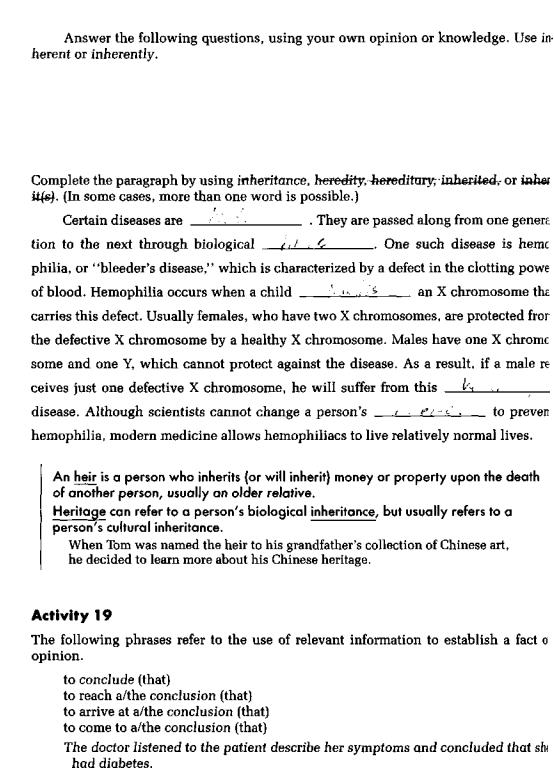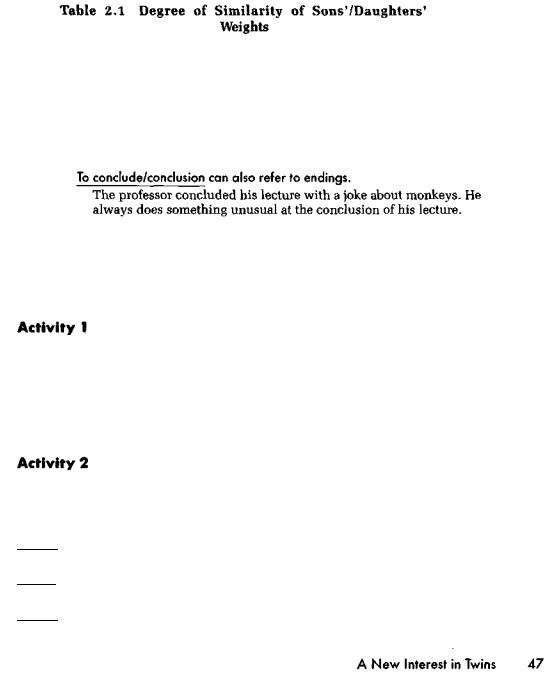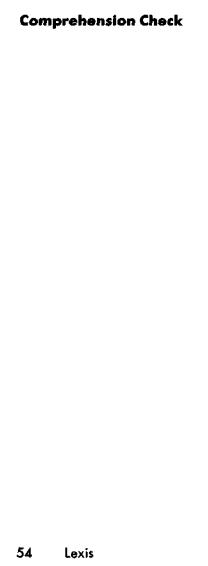
Lexis
.pdf
Notice the following sentence patterns.
Verbal skill is a characteristic of women.
Verbal skill is characteristic of women.
Women characteristically are more skilled verbally than men.
Verbal skill characterizes women's speech.
Women's speech is characterized by verbal skill.
For each of the following phrases, make a statement about one of the characteris
tics of women's speech or of men's speech. |
|
|
|
1. |
is characteristic of |
4. |
A characteristic trait of |
2. |
characterizes |
5. |
characteristically |
3. |
is characterized by |
|
|
Women are characteristically more verbal than men. They are also inherently more verbal than men. Inherently suggests a naturally occurring quality, usually biologically determined when referring to humans or animals.
Women characteristically use correct language, but this trait is probably learned rather than inherent.
Use inherently or characteristically to describe these male traits.
1. |
are stronger |
3. |
use more slang in their conversations |
2. |
have deeper voices |
4. |
marry women younger than themselves |
Inherently and inherent can also be used to describe objects or events.
Guns are inherently dangerous.
People need to be reminded of the danger inherent in keeping guns in their homes.

1.Why is gold a desirable metal for making jewelry?
2.Why do many instructors use true-false examinations?
3.Why don't most people put sugar on fruit before eating it?
Activity 18
46 Lexis

To find out if fatness is determined by heredity or environment, scientists conducted a study to compare the weights of adopted individuals with the weights of their biological parents and the weights of their adoptive parents. Use the information in Table 2.1 to write a conclusion of the study. Are the results conclusive or inconclusive? That is, do the results of the study prove without a doubt that fatness is inherited?
|
Biological |
Biological |
Adoptive |
Adoptive |
son |
mother |
father |
mother |
father |
weak |
weak |
none |
none |
|
daughter |
strongest |
strong |
none |
none |
USINGWORDSINCONTEXT
Your instructor will dictate a paragraph about Siamese twins. After you have written the paragraph, work with a partner to fill in words you may have missed or to correct grammar and spelling. When you and your partner believe your paragraphs are correct, compare them to the one printed at the back of the book. Make any necessary corrections.
The following sentences are in scrambled order. Indicate their correct order by numbering them. When the sentences are read in the correct order, they will result in a coherent story.
a.Chang and Eng, the most famous of all Siamese twins, were born in Siam in 1811.
b.On the other hand, Eng was healthier and inherently more agreeable than his sibling, and he was also distinctly quieter.
сSoon the boys learned to walk and run together and had a relatively normal childhood.

Activity 3
48 Lexis

Quintuplets
With a partner, work out the various combinations of developmental patterns for quintuplets (five babies).
Activity 4
Read the following paragraph as many times as you can in three minutes. Then with your book closed, rewrite as much of the information as you can remember.
No two individuals, not even identical twins, have identical fingerprint patterns. Because of their individuality, fingerprints are useful as a means of identification. Police often use fingerprints to determine the identity of criminals by comparing prints found at the place of a crime with the fingerprints of people who may have committed the crime. If the prints match, the police conclude that they have found the criminal. A new technique called genetic fingerprinting is now being used to identify criminals. This technique compares samples of blood or hair found at the place of a crime with samples of blood or hair taken from people who are suspected of committing the crime. Like fingerprints, elements of the genetic structure of blood and hair are individually distinctive. Recently, police in London used this technique to identify conclusively the killer of two young women.
Topics for Writing or Discussion
1.Why is the environment in which identical twins are reared more similar than the environment in which fraternal twins are reared?
2.What factors could cause identical twins to differ in appearance?
3.A child's birth order in a family is one environmental factor that can influence how the child is treated in the family. A child's sex is another factor. For example, the parents may treat the oldest child differently from the way they treat the youngest. Or they may treat sons and daughters differently. Describe some of the ways that a child's birth order and sex can influence the way he or she is reared.
4.Interest and abilities sometimes seem to run in families, perhaps as a result of both hereditary and environmental influences. Explain how both heredity and environment might produce an outstanding basketball player or a talented violinist.
A New Interest in Twins |
49 |


3
A MEASUREMENT OF TIME
ESTABLISHING A CONTEXT
Pre-reading Discussion
Why do people keep track of important dates on a calendar?
Before the calendar was invented, how did people remember important dates? What determines the seasons?
Read this article for general meaning. If you cannot understand the meaning of the content, use a dictionary to look up key words (words that are important to the meaning).
(1)Every stationery store in any modern city has a large assortment of calendars and appointment books for sale. Businesses and individuals are dependent on these for daily, weekly, and monthly planning. The need to plan ahead and to keep track of appointments and daily events has made calendars important items in our work and our personal lives.
(2)In early history, what prompted the creation of the calendar? How did humans standardize the time units of a month, a week, and a day? Using the cycles of the sun and the moon, early hunters and farmers attempted to predict rain or snow, heat or cold, and seasons for planting. Even though these early humans could predict seasons and weather cycles, they had not developed a precise way of measuring time.
(3)The Egyptians were one of the earliest civilizations to measure time in a practical way. Accomplished in astronomy, Egyptian priests had traced the position of the stars over a period of time. They knew that every summer a particular star, Sirius, appeared on the horizon just before sunrise. The priests then came to realize that there was a relationship between the position of this star and the phenomenon of three yearly cycles of the Nile River. Once a year the river rose for a four-month period, the result of rainfall and snowmelt from near its source, and inundated its banks, adding to the richness of the soil in the surrounding area. Subsequently, crops were planted and
51

grown in the rich soil over a four-month period. In a final four-month cycle, the plants were harvested. In recognition of these rhythmic phases of the river—inundation, growth, and harvest—a calendar was developed to mark seasons. This calendar, one of the earliest developed, consisted of twelve months with each month having thirty days.
(4)The Egyptian astronomers had also determined that the length of a year, based on the movement of the earth around the sun, was approximately 365 days. They had observed this cycle of a solar year as a specific time between returning seasons. To synchronize their calendar with the solar year, they added five days at the end of each year. However, they failed to account for the extra time that would accumulate over several centuries, because the actual length of a year is 365.2422 days. Thus, the Egyptian calendar progressively drifted into error over a long period of time.
(5)Other civilizations based their calendar on phases of the moon. The ancient Babylonians developed a calendar that used lunar cycles, alternating 29and 30-day months that roughly added up to a 354-day year. Like the Babylonians, the Greeks used a lunar cycle. In their system, two successive years had 12 lunar months and the third year had 13. The early Romans, borrowing their calendar from the Greeks, measured time from the beginning of one new moon to the next new moon, with some years having 12 new moons and others having 13. There was a problem in accounting for time in these systems because the actual movement of the moon varied over time, leading to a lack of uniformity in the dates of festivals or political events. To help overcome this confusion, the Romans had town criers who announced important dates. For example, since market dates varied from month to month, at the beginning of each month, the criers announced when market days would be held, and at the middle of the month they announced when rents were due. In effect, the town crier was a walking calendar. In fact, linguists speculate that the source of the word calendar may perhaps be from the Greek word kalend, meaning "I cry."
(6)What seemed to be needed in these various cultures was a common way to hold people together for making plans and for determining such matters as the planting of crops and the delivery of goods. Confusion remained as to the uniform establishment of important dates.
(7)Julius Caesar played an important role in establishing a more uniform calendar. While on a military campaign in Egypt, he learned of the Egyptian calendar, studied the system, and recognized its inaccuracies. With the help of an astronomer, Caesar designed a new calendar which was adopted in the year 47 в.с. and became known as the Julian or Roman calendar. The major differences between the Egyptian calendar and this calendar were that in the new calendar, the use of the moon to calculate time was disregarded, the number of days for each month varied, and six extra days were included by adding one day to the end of each odd-numbered month, with February having 30 days once every four years. Augustus Caesar later changed the number of days in August from 30 to 31 and deleted a day from February, establishing the present formula for leap year. This calendar was used continuously throughout the Middle Ages and as late as the 16th century.

(8)The modern calendar now used in the Western Hemisphere, known as the Gregorian calendar, came into being in 1582 when Pope Gregory attempted to reform the calendar so that specific dates would coincide with the four seasons. He adjusted the calendar so that March 21 would always coincide with the vernal equinox, the 24-hour period in the spring when day and night are of equal length. Another adjustment was to allow for the extra day that would accumulate over several centuries, a fact that the Egyptians and Caesar had overlooked or considered to be unimportant. The pope ordered that a day would be added in century years that could be divided by 400, such as 1600 and 2000. Thus, the year 2000 will be a "leap year," a year in which there are 366 days rather than 365. The Gregorian calendar basically resembled the Julian calendar, but it was more precise than any previous calendar because it coincided more accurately with the length of the solar year.
(9)Even though the Julian and Gregorian calendars were no longer based on the lunar cycle, many Christian religious celebrations, including the celebration of Easter, continued to be tied to the cycles of the moon. Throughout history, religious groups have disagreed as to the date for Easter because of the difficulty in predicting phases of the moon very far into the future. Consequently, today Easter Sunday continues to be observed on different dates in different parts of the world.
(10)The lunar calendar is still used in some cultures, such as the Hebrew, the Islamic, and the Chinese. These cultures mark traditional dates, such as the beginning of the new year, according to the lunar cycles; thus, the date varies. In the Chinese culture, the new year is observed somewhere between January 20 and February 20. For commerce, however, these cultures use the western, or Gregorian, calendar.
(11)Unlike the measurement of years and months, the length of the week is not based on a cycle of nature. It was originally based on need and spontaneous agreement. The early Romans, for example, worked in the fields seven days and went into town on the eighth day to rest and participate in local festivities, thus organizing themselves with an eight-day week. This time unit was eventually changed in the third century A.D. when Emperor Constantine converted to Christianity and followed the Old Testament model of the seven-day week. The Jews followed the religious dictates of the biblical commandment to rest on the seventh day (the Sabbath), and they preserved that day for holy observances. As Christianity expanded, the seven-day week came into common use in western Europe and later in America. Ultimately, the time unit of a seven-day week was the result of both work schedules and religious practice.
(12)In contrast to the development of the length of the week, the naming of the days of the week evolved partially from early study of the planets and partially from Roman religious beliefs. The Romans named seven planets after deities. Roman astrologers believed that each of the seven major planets influenced an hour, and through a cycle of hours and days, each planet governed the first hour of a day. Consequently, in the Romance languages (French, Spanish, and Italian, for example), the weekday names were designated according to the names of the planets. In Spanish, Monday is Lunes (Moonday), Tuesday is Martes (Mars), Wednesday is Miercoles (Mercury), Thursday is Jueves (Jupiter), Friday is Viernes (Venus), and Saturday is Sabado (Saturn). In English, on the other hand, the day names came from Norse, Gothic, and

Germanic gods and godesses. For example, Tuesday in Old English was named Tiwsday after the god Tiw, Wednesday after the god Woden, Thursday after the god Thor, Friday after the goddess Frig, and Saturday after the god Seterne. Christian missionaries added the days Sunday and Monday, the day of the sun and the day of the moon, respectively.
(13) The concept of accounting for time on a monthly, weekly, and daily basis, resulting in the development of the calendar, partially came about through the scientific study of astronomy and the cycles of nature. But more important, it came about as the result of human need—the need to predict weather and seasons, to find a common way to make plans within communities, and to establish important dates for celebrations of historical, political, and religious significance.
The purpose of this activity is to check your understanding of the article and to give practice using vocabulary words. Label each sentence true or false according to the article. If you cannot understand the meaning of a sentence, use a dictionary to look up key words.
1.An early method of keeping track of time was prompted by the need to predict seasons, weather, and temperature.
2.An early means of establishing seasons was based on the relative position of the stars.
3.The Babylonians used the concept of the solar year as a measurement of time.
4.The Egyptian year consisted of three seasons, beginning with the annual inundation of the area around the Nile River.
5.The Greek month was based on a lunar cycle.
6.Within the early Babylonian, Greek, and Roman cultures, there was uniformity in the marking of dates.
7.Before Julius Caesar, calendar makers overlooked any inaccuracy resulting from irregularity of the lunar cycles.
8.The Julian calendar disregarded the lunar cycles to calculate the length of a month.
9.Religious groups are in agreement today as to the date for the observance of Easter Sunday.
10.The Gregorian calendar was more precise than any previous calendar.
